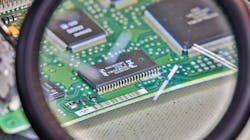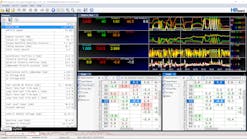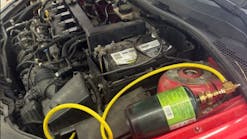Electronic services, modules, programming, and security
The average age of vehicles on the road today is approaching 12 years, which means there’s a good chance that a portion of the vehicles passing through your bays are often 15 to 20 years old. If you’re operating outside of the rust belt regions, then you’re likely to encounter much older vehicles at times. My shop is in Southern California and we encounter 30+ year-old vehicles populated with electronics quite often.
While electronic control modules have inhabited vehicles for over four decades or so, I believe most technicians have a basic understanding how electronic circuits work. This article will discuss options for module board level repairs versus replacement.
According to my research, there are no federal regulations that require automakers to provide parts support for a specific period of time. I reached out to my good friend and retired General Motors colleague, Dan Dryke, for any information to support my findings, and this is what he shared with me:
“During my time with GM, I recall that in many cases GM chose to own the tooling required to build parts, regardless of who the supplier was. Therefore, they had the ability to build parts as needed. Regarding the policies dictating how long they would support replacement parts, GM used several metrics collected through various studies in order to estimate the replacement parts market timelines. Often, these timelines would be adjusted as a result of update studies of market demands.”
As a technician, it is likely that you will begin to see (or have already witnessed) reduced electronic control module availability through the original vehicle manufacturer. Given that scenario, the next step would be to attempt to source a rebuilt or salvaged module through one of their suppliers. However, some used modules cannot simply be refitted to another vehicle due to security challenges. With such a wide range of vehicle platforms and modules requiring reprogramming, one might want to look to alternative solutions regarding module replacement.
During my conversation with Dryke, he commented that back when he was an instructor for GM he would often remind the technicians that they’re selling labor; why would they give away labor to a rebuilder when they could take apart that “fill in the blank” unit and rebuild it to like-new condition? At that time, many technicians felt there was less risk installing a replacement part.
Case Study
Your diagnostic process may take you inside the module to have a look to see if there are any clues to support your hypothesis. I know that when I suspect a fault within the module, I like to take it apart for inspection. There is always a possibility that you may be able to identify the failure and possess the ability to repair the deficiency. Just think about how this might benefit your shop and increase profits.
About 30 years ago we had an early 80’s Volvo in for a replacement engine harness. My technician informed me that after replacing the harness the engine idle speed was running at about 1,700 rpm. In the beginning of my investigation, I noticed the throttle position (TP switch) and the idle air control valve (IAC valve) used the same connector and were in the same proximity. Sure enough, the connectors were swapped. I restored the connections properly and unfortunately, the elevated engine speed continued. With the TP idle contacts closed, I knew that a dead short on a motor control circuit wasn’t going to be good for the circuit tasked with its operation.
Since I wasn’t too keen on having to buy a replacement module, I took it apart and found the two drivers for the IAC valve with one clearly blown up. I took the numbers off the transistor and found a replacement at a local Radio Shack and soldered it in place. After firing the engine back up, the idle control system operation was normal.
Industry Outreach
I reached out to one of my colleagues, Matt Fanslow, the lead technician at Riverside Automotive in Redwing, Minnesota, to talk to about his experience with internal, board-level module service. I asked him for a couple of examples where he ended up making a board level repair rather than replacing the module. Fanslow also explained the reasoning for repair over replacement.
“We recently had a vehicle come in with a dead misfire. Within 20 to 30 minutes, we had the issue diagnosed as a bad ignition coil driver within the ECM,” Fanslow says. “When we checked with the OEM, we found that this module was no longer available. However, we were able to locate a replacement unit (remanufactured) but that would take a few days to arrive, and with the high cost of the module I immediately figured out how much it would take to fix the module.
“Given the age of the vehicle and the consumer’s financial position, we decided to take the board level repair path. With the ECM pin out diagram in-hand, and after pulling the covers off the ECM, we were able to identify the location of the defective, surface-mounted transistor. With a magnifier, I was able to pull identifier numbers from the chip and head over to mouser.com and enter research mode. What I found was that the part I needed was readily available and very inexpensive. Now, since I have been performing similar board type of work for a few years now, I had all the tools available which would help me handle this task quite efficiently.”
Fanslow says several of his colleagues began repairing GM clusters found on late 90’s and early 2000’s model year vehicles. He took their lead and began offering that service in-house, by reflowing solder joints and/or replacing the stepper motors.
“At that time, I found that all I really needed to get this job done was a couple of soldering irons and a solder sucker,” Fanslow says. “Most of these tools I acquired inexpensively at Radio Shack. Today, my arsenal of tools that make up my rework station have grown through necessity and discovery, through discussions I’ve participated in with fellow colleagues.”
Fanslow says he sources his tools from sites with replacement electronic components. “Mouser (mouser.com) and Digi-Key (digikey.com) will usually have anything you need,” he says.
Jorge Menchu with Automotive Electronics Services (AESwave) says when it comes to board level repair, developing electronics repair skills is a personal investment and will separate a technician from others in the field.
“Please be aware, you don’t need to be an electronics expert if you know how to be resourceful and perform the research,” Menchu says. “There is a tremendous amount of knowledge and information, both good and bad, available on the internet. It’s very possible that you may be able find a solution through someone else’s experience.”
Menchu was working with a Fresno City College auto instructor who had a student with an older turbocharged Chrysler vehicle. The vehicle had an intermittent misfire he was trying to resolve. Through research, the student discovered through an enthusiast’s forum that the ECM in his vehicle likely has a bad capacitor causing the symptoms he was experiencing.
“The information he found contained very detailed guidance, including images that proved to be very helpful,” Menchu says. “Since the student was hesitant to take on the work, we went ahead and installed the capacitor for him. After the capacitor replacement, the symptom disappeared.” Menchu points out the student’s decision to not dive in and do the job himself was a good decision for two reasons: A likely beginner mistake would be to not notice that an electrolytic cap is polarity sensitive. Also, for those who have not worked on an electronics board before, they should pick up an old PCM and use it for practice in order to hone their soldering and de-soldering skills.
Programming
It’s no secret that many modules today are reprogrammable, and oftentimes repairs ultimately come down to updating a module’s firmware or calibration level. Reprogramming might be something that seems challenging, but if you dig a little deeper, you’ll likely find that it’s not all that difficult to do.
Most manufacturers today offer module calibration operations for ECM’s, TCM’s, and more via J2534. The J2534 standard came about as a result of the Clean Air Act and OBD-II. Many individuals and companies dedicated a lot of time and effort into developing this standard. The basic premise is that after one acquires a compliant J2534 interface and a computer with the minimums required by a vehicle manufacturer, they would be ready to update a controller.
Please also be aware that you may run into conflicts if you install multiple manufacturers’ software applications on the same computer. There are ways to get around this, such as having the hard drive partitioned in a way that would allow you to dedicate each one to a manufacturer. Look to the manufacturer for guidance, especially for info about operating systems, viruses, and security software, etc. Dedicating research time now will help you in the end.
This is not everything that one needs to ensure that the reprogramming process happens without any difficulties. One should also have a battery maintainer that can ensure that the battery voltage doesn’t dip below the minimums established by the manufacturer. As a rule of thumb, if your maintainer can maintain 13.5V while handling loads up to 75A, you’ll be ready to provide programming support for 90 percent of the market. The other 10 percent may require something that can handle currents up to 100A or so. Additionally, you’ll want to make sure you have a robust internet connection. Manufacturers usually have minimums established for these parameters as well.
Security
Security has become more prevalent today and will likely provide hurdles for you in the future. If you’re working in North America, I highly suggest that you familiarize yourself with the National Automotive Service Task Force (NASTF) at NASTF.org. NASTF has a Vehicle Security Professional (VSP) credential available which oftentimes provides security access through vehicle manufacturers. If you’ve interfaced with any of the OEM websites for scan tool and/or programming information, you have probably already seen an option for entering NASTF VSP credentials. The NASTF website is full of useful information to help you get up to speed. Additionally, if you’re working on Fiat Chrysler Automobiles (FCA), you’ll want to visit AutoAuth.com and see if your current scan tools are supported to access the FCA Secure Gateway (SGW) equipped vehicles. AutoAuth.com will require registration for your shop/owner and then the owner can add technicians to this account along with all the tools they will be using to access SGW FCA vehicles.



